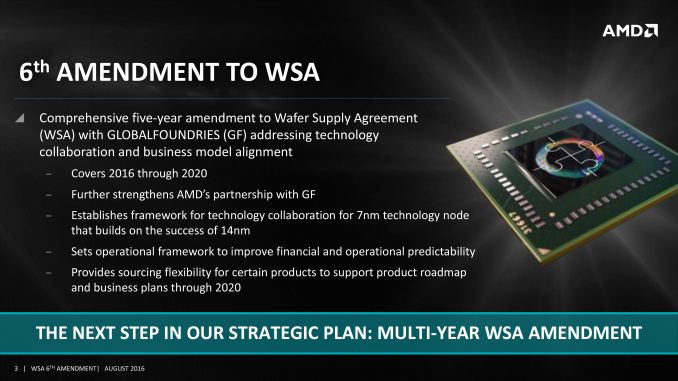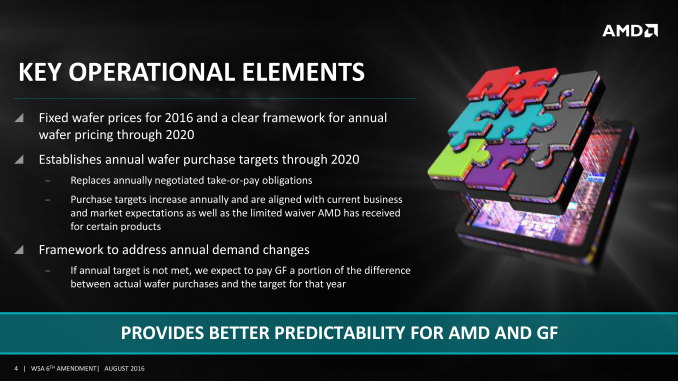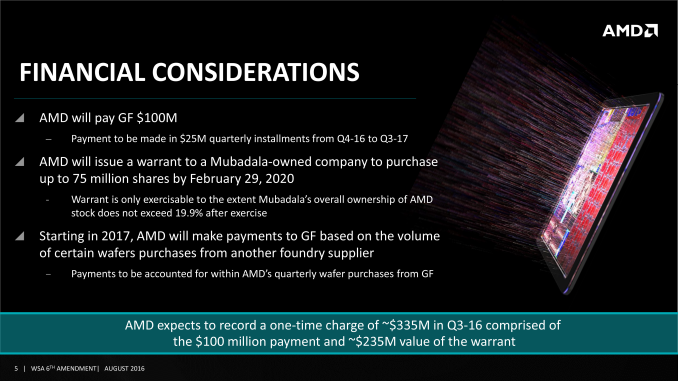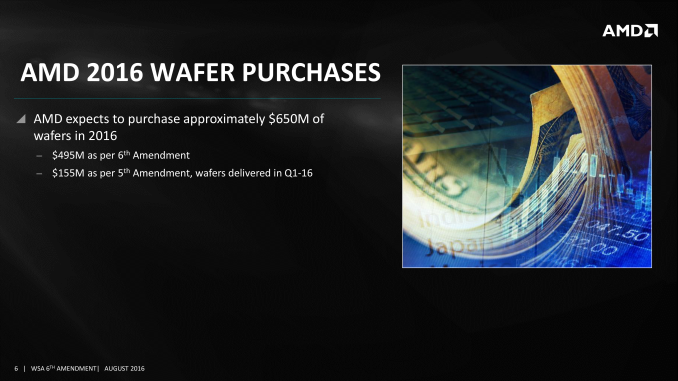AMD Amends GlobalFoundries Wafer Supply Agreement Through 2020, Gaining New Flexibility & New Costs
by Ryan Smith on September 1, 2016 6:00 AM EST- Posted in
- CPUs
- AMD
- GlobalFoundries
- APUs
- GPUs

This evening AMD has announced that they have updated their long-standing wafer supply agreement with fab parter GlobalFoundries. The new agreement, which makes some notable alterations to wafer order numbers and how the parties are compensated, covers wafer sales between the two parties through 2020.
As a bit of background here, of the many important and long-term consequences of AMD’s 2008 spin-off of their foundry business into what has become GlobalFoundries, perhaps the most significant is the Wafer Supply Agreement (WSA). As part of the plan for separating chip design and chip fabbing, AMD inked an agreement with GlobalFoundries that setup a basic framework for how many wafers AMD would buy. This essentially ensured that AMD would remain a long-term customer and GlobalFoundries a long-term supplier through the lifetime of the agreement.
The overall WSA agreement is set to run through 2024. However throughout the lifetime of the agreement, AMD and GlobalFoundries have amended it several times to account for changing market conditions, AMD’s manufacturing needs, and GlobalFoundries own manufacturing plans. Traditionally this has been a near-yearly event – the WSA has been amended 5 times before today – however for this 6th amendment, AMD and GlobalFoundries have inked a much longer 5-year amendment that will take them through 2020.
So what’s new with the latest amendment? The fundamentals have not changed; the WSA continues to ensure that AMD purchases a significant number of wafers from GlobalFoundries. However the number of wafers and how those are priced has been laid out in a different manner than previous agreements. On the pricing front, the new agreement sets fixed prices for the rest of 2016. Prices beyond that are not (yet) fixed, but according to AMD there is now a framework for how those prices are determined.
As for the number of wafers to be purchased, this is where things get more interesting. AMD of course is still committed to buying wafers from GlobalFoundries. The specific numbers are never published, but the two firms have agreed upon wafer purchase targets throughout the length of the amendment, with the targets increasing each year. Also included in the agreement are the penalties for AMD if they don’t buy enough wafers. Of particular note here, the take-or-pay agreement from past amendments has been replaced with target volumes. If AMD does not buy the targeted number of wafers, then they owe GlobalFoundries a portion of the difference. This is where the specific, undisclosed financial details make a difference, as it’s not clear if the new penalties are less than or greater than the old take-or-pay penalties.
Meanwhile, although AMD is still a significant GlobalFoundries customer, other parts of the new amendment are designed to increase AMD’s flexibility. The latest agreement lays out how and under what circumstances AMD can have products fabbed at other foundries. This is not new for AMD – they’ve been using TSMC for years alongside GloFo – however previous agreements have not been so structured in this respect.
Under this new agreement, AMD has been granted a “limited waiver” to work with other foundries “with respect to certain products in the 14nm and 7nm technology nodes.” As a result, while AMD still has to meet their overall wafer buy targets over the 5 year period, AMD also will continue working with other foundries on unspecified products where they see a need to have them manufactured at somewhere other than GlobalFoundries. It’s not clear if this really a significant departure from the status quo for AMD, but at a minimum it more rigidly defines how AMD is going to buy from both GlobalFoundries and third-party fabs.
This flexibility comes at a cost though. Not unlike past years where AMD has paid GlobalFoundries a penalty under take-or-pay, AMD will be paying the foundry for this new flexibility. GlobalFoundries will be receiving a $100M payment from AMD, spread out over the next 4 quarters. Meanwhile starting in 2017, AMD will also have to pay GlobalFoundries for wafers they buy from third-party foundries. This in particular is a notable change from past agreements, as AMD has never paid a penalty before in this fashion. Ultimately this means AMD could end up paying GlobalFoundries two different types of penalties: one for making a chip at another fab, and a second penalty if AMD doesn’t make their wafer target for the year with GlobalFoundries.
Along with all of the above, in exchange for the latest agreement AMD is making one more payment in the form of a stock warrant. The warrant itself comes with certain stipulations, but in essence AMD is issuing a warrant to GlobalFoundries’ owner Mubadala Development Company as an additional form of compensation. The warrant will give Mubadala the option to buy up to 75 million AMD shares at a currently below-market price of $5.98/share, so long as they continue to own less than 20% of AMD. AMD is valuing the warrant at $235 million, which will bring the total one-time-costs of the latest agreement to $335M.
As for AMD’s total wafer buys, the company also announced that by the end of 2016 AMD will have purchased $650 million in wafers from GlobalFoundries for the year. This is composed of $155M in wafer buys in Q1 under the old amendment, and a further $495M in Q2 through Q4 under the new agreement.
Looking at the broader picture, AMD isn’t saying how future products are being divided up among GlobalFoundries and third-party fabs, only that they’ve entered into this agreement based on what they project their future needs will be. So whether this is for CPUs, APUs, GPUs, semi-custom, or all of the above remains to be seen.
However it is interesting to note that GlobalFoundries will not be doing a 10nm process – the company is going to jump from 14nm to 7nm – so if AMD does decide to fab anything at 10nm, then it will have to be with a third-party fab. At the same time though it’s not clear how long of a shelf-life 10nm will have – there are signs it may be a short-lived process before 7nm is ready – so the lack of a 10nm process may not have much of an impact for AMD. Regardless, AMD and GlobalFoundries will be collaborating on the development of 7nm tech, so it’s clear that GlobalFoundries is expected to remain as a leading-edge supplier for AMD wafers for the next 5 years.














17 Comments
View All Comments
mrdude - Thursday, September 1, 2016 - link
In essence, GloFo has managed to get AMD to pay for GloFo's own incompetence -- and do so twice!On the other side of that coin, AMD's consumer revenue has been so atrocious that they only bought $75m worth of wafers in Q2 as per last QC. That's $75m worth of wafers between APUs, CPUs, and now Polaris GPUs combined! That's utterly laughable.
These two truly deserve each other.
Systab - Thursday, September 1, 2016 - link
Where do you see this $75M figure in Q2? Seems so low.We've known how badly GloFo has been doing (having to licence process from Samsung (who got it from that TSMC defector) etc).
mrdude - Thursday, September 1, 2016 - link
From the horse's mouth (though Devinder Kumar is far more handsome than your average horse):"Total wafer purchases from GLOBALFOUNDRIES in the second quarter was $75 million, and year-to-date, we have purchased $259 million."
That was from the last ER.
AMD has more lines of product running on GloFo fabs than ever before, yet the wafer purchases have never, ever been that low.
I want to applaud GloFo for being the straight-up gangsters that they are. They managed to get AMD to pay for every wafer that they buy from other foundries. That's some grade-A mafia stuff right there.
mrdude - Thursday, September 1, 2016 - link
I imagine the negotiations went something like thishttps://www.youtube.com/watch?v=3XGAmPRxV48
BlueBlazer - Friday, September 2, 2016 - link
Furthermore AMD still pays Global Foundries for not using their own wafers: "Meanwhile starting in 2017, AMD will also have to pay GlobalFoundries for wafers they buy from third-party foundries."Jleppard - Thursday, September 15, 2016 - link
IF Zen is what it should be it will be a total slam dunk for AMD. Between Appl, PS4 Pro, Polaris, Zen, Vega all coming at once they will need that Fab Space. If Nvidia needed that much space to make GPU's the 1080 would cost more than 700 MSRP.nothingcompares - Thursday, September 1, 2016 - link
Strange timing to do it now. There was obviously a need to get this out in the open asap.I am expecting more news in the next couple of days now that might not have been able to be made public before this announcement.
Zen production across multiple fabs to meet expected demand following the positive sample performance?
10nm Vega?
tipoo - Thursday, September 1, 2016 - link
What I'm reading is, they paid a buttload because otherwise they were stuck in a wafer silicon agreement with Glofo, so this is a really expensive way of saying your fab sucks but we're legally bound to you otherwise.Sucks that AMD was bound by it in the first place, but I'm excited that this means TSMC AMD products.
tipoo - Thursday, September 1, 2016 - link
Here's the double whammy, they also paid to get INTO the WSA...Now they have to pay their way out of Glofos crap process, after Glofo convinced them they just needed to get some things in order and the next process would be better.AMD, king of foresight....
K_Space - Thursday, September 1, 2016 - link
GloFo has no incentive to innovate if they know their largest customer is going to pay up regardless: a) by getting wafers off them b) or even if they purchase from TSMC!This WSA doesn't make sense at all! I'm gonna have to go back to the original article - even then I doubt it will make financial sense!!